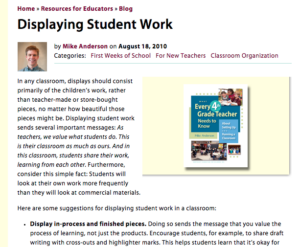Every Teacher Tips: Displaying Student Work
Original Article: https://www.responsiveclassroom.org/blog/every-teacher-tips-displaying-student-work
 In any classroom, displays should consist primarily of the children’s work, rather than teacher-made or store-bought pieces, no matter how beautiful those pieces might be. Displaying student work sends several important messages: As teachers, we value what students do. This is their classroom as much as ours. And in this classroom, students share their work, learning from each other. Furthermore, consider this simple fact: Students will look at their own work more frequently than they will look at commercial materials.
In any classroom, displays should consist primarily of the children’s work, rather than teacher-made or store-bought pieces, no matter how beautiful those pieces might be. Displaying student work sends several important messages: As teachers, we value what students do. This is their classroom as much as ours. And in this classroom, students share their work, learning from each other. Furthermore, consider this simple fact: Students will look at their own work more frequently than they will look at commercial materials.
Here are some suggestions for displaying student work in a classroom:
- Display in-process and finished pieces. Doing so sends the message that you value the process of learning, not just the products. Encourage students, for example, to share draft writing with cross-outs and highlighter marks. This helps students learn that it’s okay for learning to be messy and that mistakes are part of learning—not things to hide or avoid.
- Include everyone. Display work from each of the children, not just the “best.”
- Give students a say. Children may not be comfortable showing work that you believe is worthy. It’s respectful to check before putting a piece on display. Besides showing respect for students, giving them a say in what is displayed has added benefits: 1) Displays will be more varied and interesting, since different students will likely choose different types of pieces to display; and 2) This variety sends the message that students are valued as individuals.
- Give students their own space. If you can, create a display square for each student and let each student decide what to display there.
- Use wall space for two-dimensional work and shelf tops for three-dimensional work.Display paintings, writing samples, book reviews, and other two-dimensional work on bulletin boards and other wall spaces. Keep the tops of shelves clear for dioramas, models, and other three-dimensional pieces.
- Make displays purposeful. You don’t need to display every piece of work students do. Before you display anything, be clear about why you’re doing it and how long you’re going to leave it up.
- Remember that less is more. Covering every possible space will make the room seem cluttered and overstimulating. Leave a good amount of wall space and shelf tops clear, and leave ample borders around bulletin boards.
- Keep displays current. Take down old work. Students usually don’t care about and won’t look at work they did months ago.
- Put it at eye level—the children’s eye level. Whenever possible, put displays no higher than the children’s eye level. They’ll become frustrated by—or learn to ignore—displays above their heads.




